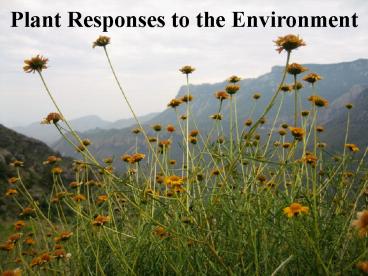Plant Responses to the Environment PowerPoint PPT Presentation
Title: Plant Responses to the Environment
1
Plant Responses to the Environment
2
Plants respond to many environmental stimuli
http//plantsinmotion.bio.indiana.edu/plantmotion/
starthere.html
3
Fig 39.16
Plants respond to the direction of light
4
How do plants detect light direction?
Fig 39.5
5
How do plants detect light direction?The
response involves differential growth in the zone
of elongation
Fig 39.5
6
How do plants detect light direction?How would
you test where the plant detects light?
Fig 39.5
7
How do plants detect light direction?
Fig39.5
8
How do plants detect light direction?Light
direction is sensed in the tip, but the response
occurs in the elongation zone
Fig 39.5
9
How do plants detect light direction? The signal
originates in the tip and travels to the
elongation zone
Fig39.5
10
How do plants detect light direction? The signal
is the plant hormone... auxin
Fig39.5
11
Fig 10.6
Spectrum of light energy
12
Photosynthesis Plants can make sugar using
energy from the sun, water from the ground, and
CO2 from the air.
13
Action spectrum of photosynthesis
Fig 10.9
14
Fig 39.17
Seedling germination may depend on light
15
Light quantity and quality in different
environments
16
Fig 39.17
Seedling germination may depend on light
17
Fig 39.19
Phytochrome a reversible receptor
18
Shade Avoidance
direct light
shade
19
(No Transcript)
20
Why is phytochrome reversible?
21
(No Transcript)
22
Plants respond to many environmental stimuli
23
Fig 39.25
Plants respond to touch...which one was touched?
24
Fig39.25
Plants respond to touch
touched
not touched
25
Another touch response in Mimosa pudica
Fig 39.26
26
Fig 39.28
Bad touch Herbivory
27
Fig 39.28
Bad touch Herbivory
systemin
28
Fig 39.28
Bad touch Herbivory
jasmonic acid
systemin
29
Fig 39.28
Bad touch Herbivory
Protease Inhibitors
Protease Inhibitors
Protease Inhibitors
methyl jasmonate
jasmonic acid
Protease Inhibitors
systemin
Protease Inhibitors
Protease Inhibitors
30
Fig 39.28
Bad touch Herbivory
Protease Inhibitors
Protease Inhibitors
Protease Inhibitors
methyl jasmonate
jasmonic acid
Protease Inhibitors
systemin
Protease Inhibitors
Protease Inhibitors
Ive got indigestion!
31
(No Transcript)
32
Fig 39.28
Plants release several volatile chemicals to
signal other organisms
33
Fig 54.1
Wasp larvae emerging from caterpillar
34
Plants release several volatile chemicals to
signal other organisms
Plant biology Night moves of pregnant
moths Clarence A. Ryan (29 March 2001) Nature
410, 530-531
35
Moth type and time
Plants release different volatiles depending on
who and when they are being eaten.
De Moraes C. M., Mescher M. C., Tumlinson J. H.
Nature 410, 577-580 (2001)
36
Plants release several volatile chemicals to
signal other organisms
Plant biology Night moves of pregnant
moths Clarence A. Ryan (29 March 2001) Nature
410, 530-531
37
Plant Responses to the Environment

